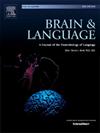重温40赫兹伽马反应:人类听觉通路的锁相神经活动与双语经验有关。
IF 2.3
2区 心理学
Q1 AUDIOLOGY & SPEECH-LANGUAGE PATHOLOGY
引用次数: 0
摘要
口语经验会影响大脑对声音的反应,但尚不清楚这种神经可塑性是否仅限于语音频率(bb0 - 100hz)或也影响较低的伽马范围(~ 30- 60hz)。利用频率跟随响应(FFR),一种对声音的远场锁相响应,我们探索双语是否会影响伽马范围内最强响应的位置。我们的研究结果表明,双语者最强烈的伽马反应通常在43赫兹,而单语者为51赫兹。使用计算模型,我们展示了这种组间差异是如何由不同的皮层下激活引起的。这些结果揭示了在伽马范围内观察到的众所周知但未被充分探索的变异性,并强调ffr是皮层下和皮层源的神经活动的复合。此外,我们的研究结果强调,个体听觉体验可以独特地塑造皮层下激活,影响语音频率以下的ffr。本文章由计算机程序翻译,如有差异,请以英文原文为准。
Revisiting the 40-Hz gamma response: Phase-locked neural activity along the human auditory pathway relates to bilingual experience
Spoken language experience influences brain responses to sound, but it is unclear whether this neuroplasticity is limited to speech frequencies (>100 Hz) or also affects lower gamma ranges (∼30–60 Hz). Using the frequency-following response (FFR), a far-field phase-locked response to sound, we explore whether bilingualism influences the location of the strongest response in the gamma range. Our results indicate that the strongest gamma response for bilinguals is most often at 43 Hz, compared to 51 Hz for monolinguals. Using a computational model, we show how this group difference could result from differential subcortical activation. These results shed light on the well-known but under-explored variability observed in the gamma range and highlight that FFRs are a composite of neural activity from both subcortical and cortical sources. Additionally, our findings emphasize that individual auditory experiences can uniquely shape subcortical activation, influencing FFRs below speech frequencies.
求助全文
通过发布文献求助,成功后即可免费获取论文全文。
去求助
来源期刊

Brain and Language
医学-神经科学
CiteScore
4.50
自引率
8.00%
发文量
82
审稿时长
20.5 weeks
期刊介绍:
An interdisciplinary journal, Brain and Language publishes articles that elucidate the complex relationships among language, brain, and behavior. The journal covers the large variety of modern techniques in cognitive neuroscience, including functional and structural brain imaging, electrophysiology, cellular and molecular neurobiology, genetics, lesion-based approaches, and computational modeling. All articles must relate to human language and be relevant to the understanding of its neurobiological and neurocognitive bases. Published articles in the journal are expected to have significant theoretical novelty and/or practical implications, and use perspectives and methods from psychology, linguistics, and neuroscience along with brain data and brain measures.
 求助内容:
求助内容: 应助结果提醒方式:
应助结果提醒方式:


